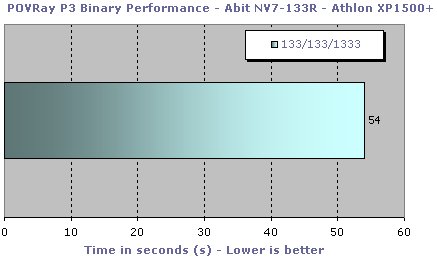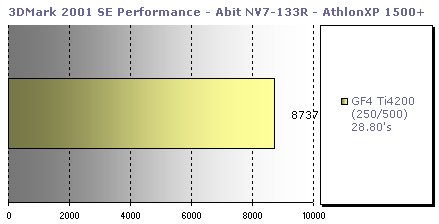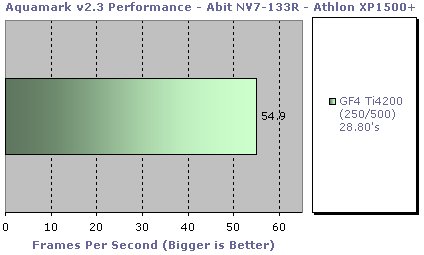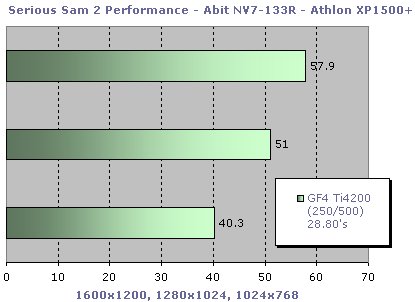|
We'll be looking at performance from our usual gamut of angles including our game based benchmarks, Sandra and POVRay performance.
Before we move onto the results themselves, lets take a look at the test system.
- Abit NV7-133R ATX Socket A DDR Motherboard (nForce 415D chipset)
- AMD Athlon XP1500+ Processor (1.33GHz, 10 x 133)
- 1 x 256Mb Samsung PC2700 DDR Memory Module (CAS2)
- NVIDIA GeForce4 Ti4200 64MB AGP
- Adaptec 39160 PCI SCSI Dual Channel U160 controller
- 2 x 73Gb Seagate Cheetah U160 10,000rpm SCSI disks
- Plextor 12/10/32S SCSI CDRW
- Pioneer 6x Slot-load SCSI DVD
- Windows XP Professional Build 2600.xpclient.010817-1148
- DetonatorXP 28.80 NVIDIA drivers
- Aquamark v2.3
- Quake3 v1.30
- POVRay v3.1g.msvc.unofficial-win32 dated 28 August 2001
- 3DMark 2001 Professional Second Edition
- SiSoftware Sandra v2002.2.8.64
- Serious Sam: The Second Encounter Demo
For the last while I've used, faithfully, a GeForce3 Ti500 for my motherboard reviews. It was a lovely example from Gainward and it clocked beautifully but sadly, it has moved on to sunnier climates leaving my review system in a state of flux for this article. So for this review only, NVIDIA's GeForce4 Ti4200 64MB reference card is stepping into the breach to provide us with some numbers on the NV7-133R. Future reviews will step up to an MSI Ti4400. So a fond fairwell to the Gainward and a quick, if only fleeting, hello to the Ti4200!
This card change brings with it a change in display driver to 28.80 but apart from that, the specification remains the same as always.
Finally, you wont see overclocking results in this review. I discussed earlier the front side bus options and low CPU voltage adjustment that you get. While you have options above 133MHz in the BIOS, I couldn't make the NV7-133R boot successfully at any of them above 140MHz. I'm using a processor that can do 1.6GHz at default CPU voltage and some good DDR333 memory that has no issues whatsoever running at up to around 180MHz without any increase in DDR voltage.
Just like all the previous nForce boards I've seen, overclocking has been disabled or just plain doesn't work. The chipset doesn't seem to like being run out of specification at all.
Onto the numbers. We'll start by using Sandra and POVRay for come quick chipset and CPU analysis to make sure everything is working as it should, then onto the 4 game-based 3D benchmarks.
So to start with, the Sandra Memory Bandwidth Benchmark. I dispense with the CPU Arithmetic and CPU Multimedia Benchmarks these days since the results hardly change from motherboard to motherboard. Rest assured the numbers were run and they looked fine for the host processor.

With the CPU to memory controller host clock being 133MHz in the benchmark, the processor can make use of around 2.1GB/sec (~2100MB/sec) so looking at the graph you can see that the nForce memory controller, operating here in normal 64-bit mode (no Twinbank, something I'll cover shortly) you can see that the chipset, without the integrated GeForce2 graphics core to hold it back, is very efficient.
The integrated graphics core in the 420D (using IGP-128 bridge) uses a small amount of memory bandwidth from the memory controller, even when you aren't using it so the memory bandwidth suffers slightly. Here, unhindered, the performance is excellent and very efficient.
A quick look at POVRay to ensure that the CPU is allowed to work properly on the board.

54 seconds is what we expected. While the nForce has a technology called DASP to speculatively select the next instructions and data that the processor is likely to need, it can't help with POVRay since the instruction set that POVRay uses is repetitive.
Onto our game based benchmarks. 3DMark 2001 SE is a DirectX 8 based 3D benchmark that stresses the major components in your system. What we are looking for here is performance to match that of the KT333 chipset that we saw in our recent look at the EPoX 83KA. We know that nForce is able to beat the KT266A at default clocks so it will be interesting to see how it holds up against KT333. For reference, using the same video card and driver set, the EPoX scored 8864 marks.

We concede just over 100 points to KT333, slightly down on what I was expecting but impressive all the same. Reasons for this are most likely a now slightly slower memory controller in nForce compared to the highly tweaked controller in the VIA chipset. There isn't much in it however and nothing you'd notice in the real world.
Next up, Aquamark. Aquamark is another DX8 based benchmark, this time dependant on programmable shader hardware for good performance. The Ti4200 provides that so the Abit board is on its own to try and match the performance of the EPoX 8K3A. For reference, the 8K3A scored 55.1fps in this test using the same graphics card and driver set.

We lost 0.2fps here over KT333 which is nothing in the real world. Usually I'd put that down to normal testing variance but due to the difference in the 3DMark score and the fact it was repeatable over 3 runs (identical scores each time) we have to concede to KT333. The nForce still does well here however and it's quicker than KT266A.
Lastly in our look at game based benchmarks, we have an actual game! Serious Sam 2 is a favourite of ours here at Hexus since it's easy to benchmark and nice to look at (always a good thing). Again, since we are using the Ti4200 as our graphics card, the valid comparison is against KT333 and the EPoX.

We are less than a frame per second down on the EPoX here. We are slightly CPU limited with the little XP1500 so the difference is negligible in the real world. For all intents and purposes, in Serious Sam 2 at least, the NV7-133R is just as fast as KT333 boards given the same CPU and graphics card.
|